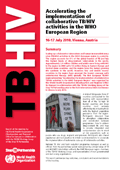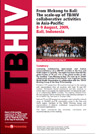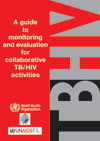TB/HIV meeting held in conjunction with the 14th conference on retroviruses and opportunistic infections
Summary
The Global TB/HIV Working Group of the Stop TB
Partnership in collaboration with the Consortium to Respond
Effectively to the AIDS TB Epidemic (CREATE) has organized a TB/HIV
meeting in conjunction with the 14th Conference on retroviruses and
opportunistic infections in Los Angeles, USA. About 40 leading
researchers in the field attended the meeting and was co-chaired by
Dr D. Havlir, chairperson of the Global TB/HIV Working Group and Dr
S. Lehrman Director, Therapeutics Research Program, Division of
AIDS, NIH, USA. The main objective of this meeting was to
familiarise selected participants of the Conference with the
functions of the Global TB/HIV Working Group (WG) of the Stop TB
Partnership and to share and discuss key TB/HIV research issues and
ongoing efforts. The meeting raised the awareness about the Global
TB/HIV WG and a one pager brief about the WG was distributed.
Presentations were done and discussions conducted about the ongoing
research efforts and priorities around key areas (see presentations
below). The importance of TB prevention in people living with HIV
has been emphasized and research priorities including screening
algorithms to rule out TB and best tools to diagnose latent TB were
discussed. The possibility of developing a single prophylaxis tablet
for people living with HIV for the commonest opportunistic
illnesses, including TB was raised during the discussion. The
research priorities and ongoing efforts about ART for TB patients
were presented. However, it was appalling to learn that most of the
reported studies that intended to study ART delivery among TB
patients were either stopped or crinkling, which was worrisome
particularly in the face of the multiple unanswered questions of ART
delivery in TB patients. The case definition of Immune
reconsistition syndrome (IRIS) in TB patients, which was the outcome
of an earlier meeting that was held in Uganda, Kampala has been
presented. The following major and minor criteria were presented.
Major criteria include: (1)New/enlarging lymph nodes, cold abscesses
or other focal tissue involvement; (2) New/worsening radiological
features of TB; (3)Breakthrough TB meningitis or new/enlarging focal
CNS lesion; (4)New or Worsening serositis. Minor criteria include:
(1)Constitutional symptoms- e.g., fever, night sweats;(2)
Respiratory symptoms - e.g., cough, dyspnea, stridor;(3) Abdominal
pain and/or hepatomegaly;(4) Resolution of clinical and/or
radiological findings without change in TB treatment. A patient is
classified as TB IRIS if has one major or 2 minor criteria. The
urgent research priorities to accelerate the implementation of the
new global recommendations to expedite the diagnosis and management
of TB in HIV prevalent and resource constrained settings and the
research priority implications of extensively resistant TB(XDR TB)
were presented. There was high level of interest from the
participants on all topics and it was agreed that a follow-up
meeting in conjunction with the upcoming IAS 2007 Conference in
Sydney will be useful. It was suggested that the WG should find a
systematic way of registering and following up ongoing clinical
trials of ART in TB patients in a more updated way through constant
and close consultation with partners such as the NIH. It needs to
develop a targeted research advocacy agenda and monitor the
implementation of the research priority questions identified in 2005.


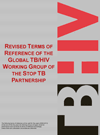
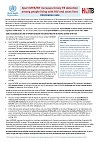

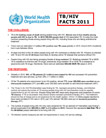

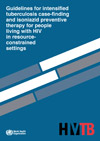 Intensive case finding and isoniazid preventive therapy guidelines, 2010
Intensive case finding and isoniazid preventive therapy guidelines, 2010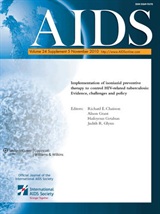
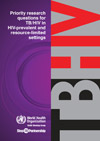 Priority research questions for TB/HIV in HIV-prevalent and resource-limited settings, 2010
Priority research questions for TB/HIV in HIV-prevalent and resource-limited settings, 2010